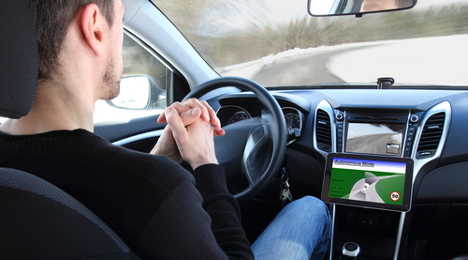How NHTSA is preparing for auto tech ‘revolution’

The U.S. Department of Transportation’s National Highway Traffic Safety Administration hosted a media conference call on Friday, outlining its current actions and future plans to prepare for the impending legislative needs of the United States in regards to future automated automobile technologies.
NHTSA’s communications director Gordon Trowbridge fielded many questions from journalists and industry analysts, including quite a few trying to get a better idea of when we can expect automated technologies, such as self-driving vehicles, to actually become a widespread reality. In short, Trowbridge made it clear that NHTSA’s role in the situation is to make sure it is prepared when such technologies do become widespread, not to decide when it actually happens.
The fact that the automotive and technology industries appear to be getting closer to making self-driving cars a reality in the next decade is evident, however, and NHTSA says it is taking several further actions to prepare.
One such action is to hold two separate public meetings in April to allow interested parties to come and provide feedback to NHTSA with their concerns and suggestions to help the federal body develop guidelines for the safe development of automated safety technologies.
The first will be held on April 8 in Washington, D.C.; the second will be held later in April at a yet-to-be-disclosed location in California, according to Trowbridge. He says that additional information for the California meeting, including the time, location and how the public can participate, will be released soon.
Trowbridge also said that NHTSA has engaged in a number of conversations with state legislations to get a dialogue rolling to keep the lines of communications open between state and federal governments on the topic of automated vehicle technologies. In terms of who will decide whether a vehicle’s automated technologies are safe, whether it be state or federal authorities, is still undefined.
In a release from NHTSA, Transportation Secretary Anthony Foxx commented on the organization’s goals in this situation.
“We are witnessing a revolution in auto technology that has the potential to save thousands of lives,” Foxx said. “In order to achieve that potential, we need to establish guidelines for manufacturers that clearly outline how we expect automated vehicles to function — not only safely, but more safely — on our roads.”
Establishing operational guidelines is just one of five of NHTSA’s initiatives that Foxx announced in January during the North American International Auto Show in Detroit. Here are the other four, as NHTSA listed in the release:
- President Obama’s budget proposal for a 10-year, $3.9 billion investment in advancing autonomous vehicle technology, including large deployment pilots in communities around the country.
- Working with states to develop model state policy.
- Using NHTSA’s existing authority to interpret current regulations, and offer limited exemptions from those regulations, in pursuit of advances that could increase safety.
- Determining what new regulatory tools and authorities might be required to meet NHTSA’s safety mission in an era of rapidly changing technology.
NHTSA also released its initial assessment of current Federal Motor Vehicle Safety Standards to identify the key challenges ahead between now and the full deployment of automated vehicles.
The report, prepared by the USDOT’s Volpe National Transportation Systems Center, basically found that there are very few existing federal regulatory hurdles for the deployment of automated vehicles that feature traditional designs and equipment that accommodate a human driver, for example those containing traditional controls like a steering wheel, gas and brake pedals, etc. According to Trowbridge, the biggest challenge will be in the area for new automated vehicles designs that don’t feature such traditional designs.
NHTSA Administrator Mark Rosekind commented on the findings of the report in a release from the administration earlier today.
“The Volpe Center report is a great first look at current standards, and it highlights the need for the actions Secretary Foxx outlined in January,” Rosekind said. “It also shows there are few current restrictions on some automated vehicle concepts, which highlights the need to establish clear expectations for their safe operation. At the same time, for other vehicle designs, the agency has more work to do to ensure the safety of new innovations, and we look forward to learning more from stakeholders as we start that work.”
The full report from The Volpe Center can be accessed here.

 View The Latest Edition
View The Latest Edition

